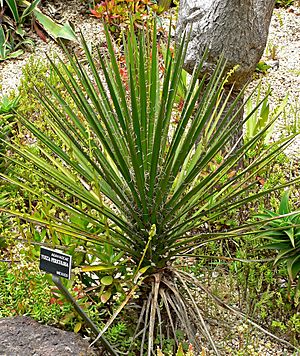Izote facts for kids
Quick facts for kids izote |
|
|---|---|
 |
|
| Conservation status | |
| Scientific classification | |
| Synonyms | |
The Izote (pronounced "ee-SOH-tay") is a cool plant also known by its scientific name, Yucca periculosa. It belongs to the Asparagaceae family, which includes plants like asparagus! You can find it growing naturally in several states of Mexico, like Veracruz, Morelos, Guerrero, Puebla, and Oaxaca.
This plant can grow quite tall, up to 6 meters (about 20 feet)! It looks like a tree with branches and produces beautiful creamy white flowers.
Contents
What is the Izote?
The Izote is a type of yucca plant. Yuccas are known for their tough, sword-shaped leaves and tall flower stalks. The Yucca periculosa is special because it grows very large, almost like a small tree. Its name "periculosa" might sound scary, but it just refers to some of its features.
Appearance of the Izote
The Izote plant has a strong, woody trunk that can branch out. Its leaves are long and narrow, often with sharp tips, which is common for yucca plants. When it blooms, it sends up a tall stalk covered in many creamy white flowers. These flowers often hang down like bells.
Where the Izote Grows
This plant loves warm, dry places. It is native to specific regions in Mexico, which means it naturally grows there. These areas often have sunny weather and well-drained soil, perfect for the Izote to thrive.
Uses of the Izote Plant
For a long time, people have found many uses for the Izote plant. Different parts of the plant can be used for various things.
Traditional Uses
- Food: The flowers of the Izote plant are actually edible! In some parts of Mexico, people cook and eat them. They are often used in traditional dishes.
- Fiber: Like many yucca plants, the leaves of the Izote contain strong fibers. These fibers can be used to make ropes, baskets, and even clothing.
- Soap: The roots of some yucca plants, including the Izote, contain natural soap-like substances called saponins. These can be used to make natural soaps and shampoos.
Life Cycle and Reproduction
Like all plants, the Izote goes through a life cycle. It starts from a seed, grows into a mature plant, flowers, and then produces new seeds.
How Izote Reproduces
The creamy white flowers of the Izote are very important for its reproduction. These flowers are pollinated, often by special moths that have a unique relationship with yucca plants. After pollination, the flowers develop into fruits that contain seeds. These seeds can then grow into new Izote plants.
Conservation Status
The Izote, or Yucca periculosa, is listed as "Near Threatened" by the IUCN Red List.
What "Near Threatened" Means
When a plant or animal is "Near Threatened," it means that it is not currently in danger of disappearing, but it could become threatened in the near future. This might happen if its habitat is destroyed or if too many plants are collected from the wild. Scientists keep an eye on these species to make sure they stay safe. Protecting their natural homes is very important to help them survive.
See also

- In Spanish: Yuca pie de elefante para niños


